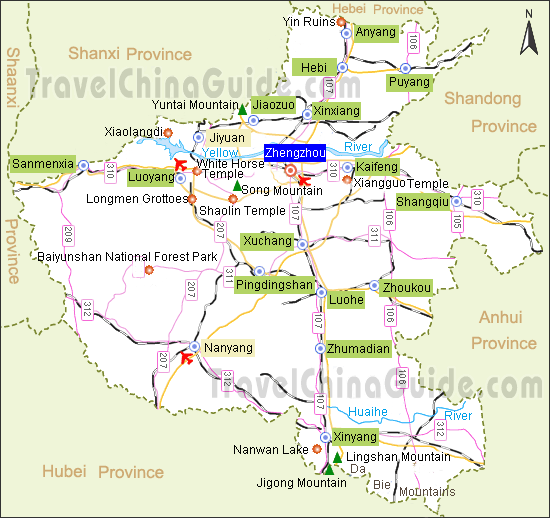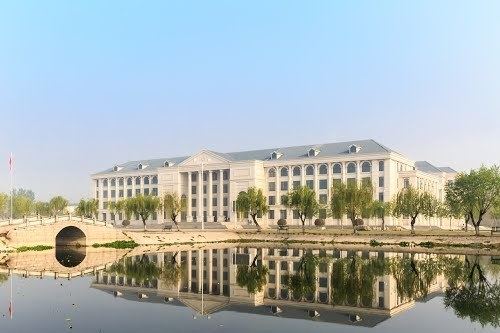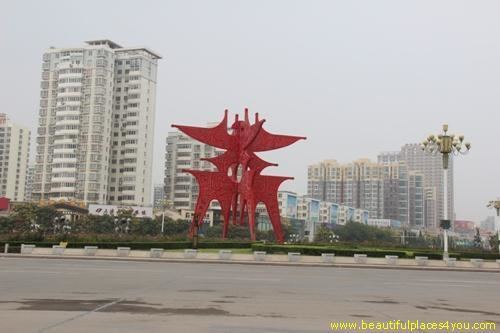Country Peoples Republic of China University Shangqiu Normal University Area 10,704 km2 | ||
Shangqiu (Chinese: , Shangqiu), formerly romanized as Shangkiu, is a city in eastern Henan province, Central China. It borders Kaifeng to the northwest, Zhoukou to the southwest, and the provinces of Shandong and Anhui to the northeast and southeast respectively. An ancient city with a rich history, Shangqiu was also the first capital of the Shang dynasty. Its population was 7,362,975 inhabitants at the 2010 census whom 1,536,392 lived in the built-up (or metro) area made up of Liangyuan and Suiyang districts.
Contents
- Map of Shangqiu
- History
- Geography and climate
- Economy
- Society and culture
- Biomass burner for boilers equipment drying equipment food drying equipment
- References
Map of Shangqiu
Once merely a small village, Shangqiu has grown significantly in recent years. It is important geographically because it lies at a junction of several major railways, making its train station a major regional transportation hub.
History

The history of Shangqiu is closely related to the very beginning of Chinese history. Tradition dates back to the Three August Ones and Five Emperors periods (c. 25th century BC), when the semi-legendary Emperors Shennong, Zhuanxu and Ku were said to be living in the present Shangqiu area. The son of Emperor Ku, Qi (), who helped Yu the Great to control floods, was enfeoffed the area of Shang (which is the current day Shangqiu area), who also became the ancestor of the ancient nationality of Shang. It is said that the Shang people first started trading with neighboring countries by shipping the goods with ox wagons. Since then, people doing business are called Shang people (Shangren , means businessman), which is still the case now, although people are not likely to know the origin of the words. Shangqiu was also reportedly one of the capitals defended by the Xia emperor Xiang, troubled by rebellions in his reign. The thirteenth generation grandson of Qi (), Tang overthrew the ruling Xia Dynasty and founded the Shang Dynasty, with its first capital at Nanbo (, currently south of Shangqiu). Around the 11th century BC, the Shang Dynasty was replaced by the Zhou Dynasty. The royal descendants of Shang Dynasty were enfeoffed the area of Shangqiu, which later became the state of Song.

The city was the southern capital of the Northern Song dynasty under the name Nanjing. Shangqiu was the first in a series of temporary capitals that the Song Dynasty government moved to during their retreat from the north, when most of northern China had been conquered by the Jurchens in the Jin–Song wars. The Song court had retreated south to the city from their original capital in Kaifeng, after it was captured by the Jurchens in the Jingkang Incident of 1127. The court moved to Shangqiu because of its historical importance to Emperor Taizu of Song, the founder of the dynasty, who had previously served in the city as a military governor. The symbolism of the city was meant to secure the political legitimacy of the new Emperor Gaozong, who was crowned emperor of China in Shangqiu on June 12, 1127. The capital was again moved in 1128 to Yangzhou, and finally to Hangzhou in 1129.
Under the Republic, Shangqiu was considered a key city in eastern Henan owing to its position along the Lunghai (now Longhai) Railway between the port of Haizhou on the East China Sea and Lanzhou in central China. It was known at the time as Kweiteh, Kwei-teh, or Kuei-te (Chinese: t , s , p Guide) and had both a Catholic diocese and an Anglican mission, the later of which ran St Pauls Hospital. It changed hands frequently during the fighting among the Chinese warlords in 1927.
Geography and climate

Shangqiu is the easternmost prefecture of Henan province. Its administrative area ranges in longitude from 114 °49? E to 116° 39? E and in latitude from 33° 43? N to 34° 52? N, covering 10,704 square kilometres (4,133 sq mi). The city lies on the North China Plain and is mostly flat, with elevations ranging from 30 to 70 metres (98 to 230 ft), though the northwest part of the prefecture is more elevated than the southeast.

Shangqiu has a monsoon-influenced humid subtropical climate (Koppen Cwa), with four distinct seasons. Winters are cool and mostly dry while summers are hot and humid; spring is warm and sees some, but not much rainfall, while autumn weather is crisp and drier. The monthly 24-hour average temperature ranges from around the freezing mark in January to 26.9 °C (80.4 °F) in July, while the annual mean is 14.10 °C (57.4 °F). Close to two-thirds of the annual precipitation occurs from June to September.
Economy
Situated on the North China Plain, Shangqiu is part of a traditionally agricultural region. The fertile soil and convenient irrigation facilities greatly help the production of crops and other plants. As of 2005, there are about 719,864 hectare planted. The most important agricultural products are wheat, maize, cotton, sesame, vegetables, fruit, tobacco, and livestock. In 2002, it produced about 4.5 million tons of crops, 200 thousand tons of cotton, 1.1 million tons of fruits, and 550 thousand tons of livestock.
Society and culture
Lying in the heart of the North China Plain, Shangqiu benefits from a deep cultural tradition. The first star observatory in China, Ebo Tai, was established in Shangqiu. Yingtian Shuyuan, one of the largest four official education agencies in north Song Dynasty, is located in the Suiyang district of Shangqiu. The Suiyang traditional city, which was built in 1511 during the Ming Dynasty, is one of the best protected traditional cities in China, and was enlisted as one of the famous historical cities in China by the central government in 1986. The rich culture also raised many famous cultural figures. Cangjie (Cang Jie ??), the legendary inventor of Chinese characters, was living in Shangqiu in the far-ancient periods. Zhuangzi (Zhuang Zi ??), the great ancient philosopher of China, was born here around the 4th century BC. Another great philosopher, Mozi (Mo Zi ??), living in the same period as Zhuangzi, was also a Shangqiu native. The famous woman warrior, Hua Mulan (Hua Mulan ???), was also among the great figures of Shangqiu.
